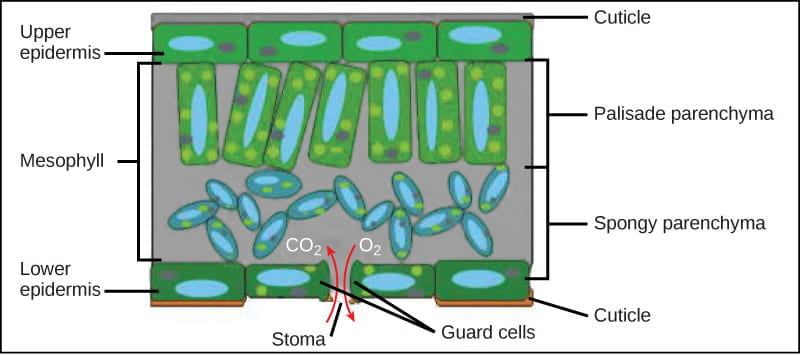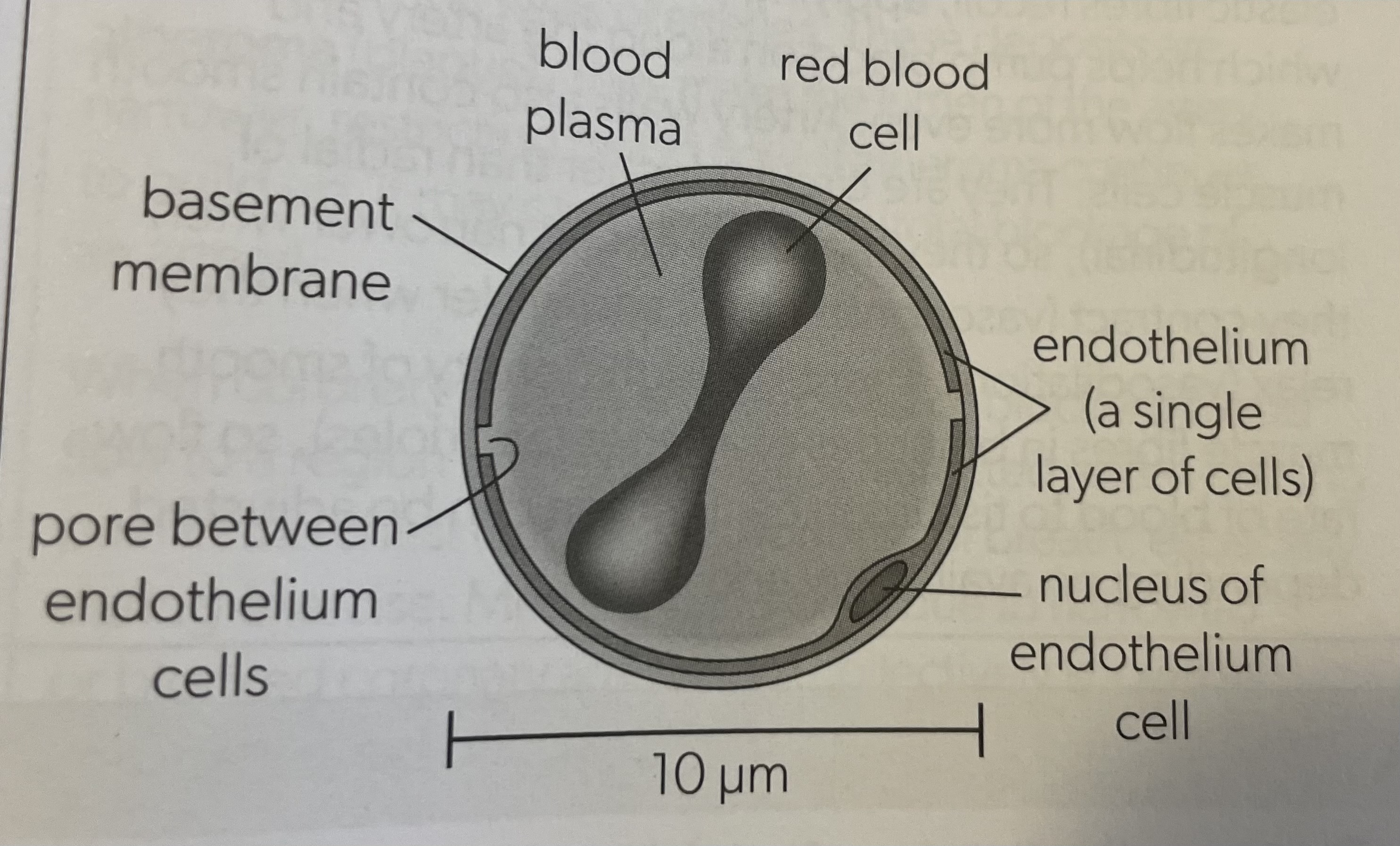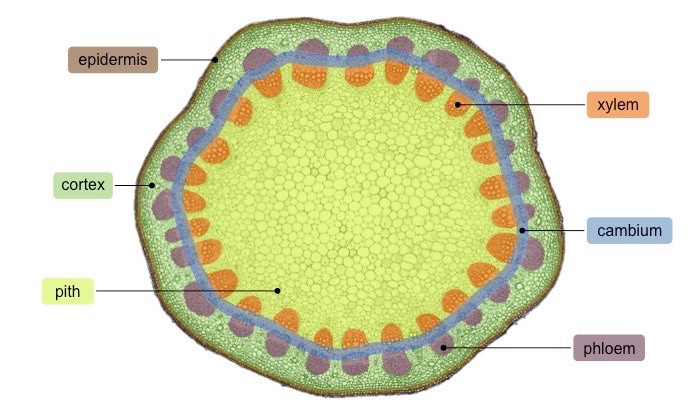B3 - Gas Exchange and Transport
1/53
There's no tags or description
Looks like no tags are added yet.
Name | Mastery | Learn | Test | Matching | Spaced |
|---|
No study sessions yet.
54 Terms
Gas Exchange
Organisms absorbing one gas and releasing another
Surface Area-to-Volume Ratio Gas Exchange
Smaller in larger organisms so they require specialized inner surfaces.
Features of Gas Exchange Surfaces
Permeable - O2 and CO2 can diffuse freely
Large - Surface area is large in relation to volume
Moist - Covered by film of moisture for gases to dissolve
Thin - Gasses diffuse short distance
Concentration Gradients in Small Organisms
Cell respiration maintains gradients
Oxygen is continuously used and CO2 is produced, so oxygen concentration within remains lower than outside
Concentration Gradients in Large Organisms
Pumping is required to maintain gradients.
Air or water adjacent to gas exchange surface is replaced through process of ventilation
Airway for Ventilating Lungs
Nose, mouth, trachea, bronchi and bronchioles
Ventilation Air Pressure
Gas always flows from high pressure to low pressure. Muscle contractions cause air pressure changes in the thorax that pull extra air into the alveoli then push it out again.
Inspiration (Inhaling)
External intercostal muscles contract, moving ribcage up and out
Diaphragm contracts, flattening and moving down
Increased thorax volume
Pressure inside thorax drops below atmospheric pressure
Air flows into the lungs until air pressure rises
Exhalation (Exhaling)
Internal intercostal muscles contract, moving ribcage down and in
Abdominal muscles contract, pushing diaphragm up
Decreased thorax volume
Air flows out from the lungs
Lung Adaptations for Efficiency
Airways
Large surface area
Extensive capillary bed
Short distance for diffusion
Most surface with surfactant
Airways Adaptation
Consist of branching bronchioles ending in alveolar ducts.
Large Surface Area Adaptation
Large number of alveoli (300 million) creating surface area 40x greater than outside body
Extensive Capillary Bed Adaptation
The surface area of the networks of blood capillaries is almost as large as the alveoli themselves
Short Distance for Diffusion
Single layers of extremely thin cells so air and blood are a short distance apart. Less than a micrometre
Moist Surfactant Adaptation
Fluid secreted by cells in alveolus walls that keep the lining moist allowing gas to dissolve. Reduces surface tension and prevents sides from sticking together causing lung collapse.
Ventilation Rate
The number of times that air is drawn in or expelled per minute
Tidal Volume
Volume of fresh air inhaled or volume of stale air exhaled with each ventilation
Vital Capacity
The total volume of air that can be exhaled after maximum inhalation.
Inspiratory Reserve Volume
Amount of air a person can inhale forcefully after normal tidal inhalation.
Expiratory Reserve Volume
Amount of air a person can exhale forcefully after normal tidal exhalation
Lung Volumes

Spirometer
Device used to measure lung volumes and flow rates into and out of lungs.

Waxy Cuticle Leaf Adaptations
Upper and lower surface of leaves is covered in waterproof wax. Reduces water loss but also prevents gas movement
Guard Cell Leaf Adaptations
Pairs of guard cells in epidermis and can open or close pores. Pores are called stomas. Stomas are normally closed at night when photosynthesis isn’t happening.
Air Space Leaf Adaptations
Stomata connect the air outside to a network of air spaces in the spongy mesophyll allowing for diffusion.
Spongy Mesophyll Leaf Adaptations
Inner tissue of leaf with extensive air spaces. Provides large total surface area. Photosynthesis maintains the concentration gradients.
Vein Leaf Adaptations
Xylem vessels located in veins replace water lost by evaporation.
Leaf Tissues

Water Evaporation
When hydrogens bonds between molecules break and become water vapour.
Transpiration
Loss of water vapour from the leaves and stems of plants. Is affected by environmental factors.
Factors Affecting Transpiration
Temperature (positive correlation): More energy available to break hydrogen bonds
Humidity (negative correlation): Reduces concentration gradient of water vapour
Wind: Increases transpiration by moving pockets of air, but stomata close with strong wind
Stomatal Density
Number of stomata per unit area of leaf surface.
Measuring Stomatal Density
Sample of epidermis peeled from leaf and examined with miroscope
Colourless nail varnish painted to form a cast. When dried it is peeled off and examined with microscope
Surface of leaf is photographed and micrograph is used for stomatal counts
Stomatal Density = (Mean number of stomata)/(area of field view)
Capillary Structure

Adaptations of Capillaries
Large surface area: Narrowest blood vessels. Capillary network has huge total length with narrow diameter
Thin walls with pores. Allows for small/medium molecules to pass through
Fenestrations: Large pores allowing larger volumes of tissue fluid to be produced. Speeds up exchange between tissue cells and blood.
Arteries
Carry pulses of high pressure blood away from the heart to every organ of the body
Veins
Carry stream of low pressure blood from the organs back to the heart.
Structural Features of Arteries
Thicker walls
Narrower lumen
Circular in section
Inner surface corregated
Fibres visible in the wall
Structural Features of Veins
Thinner wall
Wider lumen
Circular/flattened
Inner surface smooth
No or few fibres visible
Layers of Arteries
Tunica externa - outer coat, connective tissues with tough collegen to prevent swelling despite high pressure
Tunica media - thick layer containing smooth muscle and elastic fibres for pumping
Tunica intima - smooth endothelium lining the artery and reducing resistance to flow
Lumen - space in which the blood flows
Pulse Oximeter
Digital way method to measure pulse using LEDs shining light into finger and detectors measure how much light is absorbed depending on the amount of blood in the tissues
Layers of Veins
Tunica Externa: tough outer coat of protective tissue
Tunica Media: Thin layer with few elastic or collagen fibres because there is low blood pressures
Tunica Intima: smooth endothelium to reduce resistance
Lumen: relatively wide space to accommodate slow moving blood
Vein Valves
Because of low pressure there is a risk of backflow. Valves prevent this. Each consists of 3 pocket-shaped flaps that are closed by blood flowing backwards and opened by blood flowing towards the heart.
Atheroma
Plaque caused by the deposition of lipids including fats and cholesterol in the walls of arteries. They narrow the lumen, restricting blood flow.
Occlusion
Total blockage of the artery caused by the build up of plaque (atheroma)
Coronary Heart Disease
Medical conditions due to narrow or blocked arteries. When blood flow to regions of the heart wall is restricted, causing pain in the chest (angina) or shortness of breath.
Risk Factors of Coronary Heart Disease
High blood pressure (hypertension)
Smoking
Obesity
Inactive lifestyle
Family history
Old age
High blood cholesterol
Diabetes
Capillary Action
Water lost by evaporation is replaced by water drawn through pores between cellulose molecules in leaf walls. This is due to adhesion of water to cellulose and cohesion between water molecules.
Xylem Vessels
In leaf vein where water is drawn through. Tensions are generated inside when water is drawn out of them.
Transpiration Pull
Cohesion of water allows for tension to be transmitted down the columns of water down to the roots. Allows passive transport against the force of gravity. Creates a rope-like resistance due to hydrogen bonding.
Adaptations of Xylem Vessels
Wall thickening and lignification - Thickened walls impregnated with polymer lignin. Prevents collapse when low pressure
Lack of end walls and cell contents - creates continuous tubes so flow of xylem sap is unimpeded
Pits for entry and exit of water - Wall thickenings are impermeable so there are gaps allowing water to enter and exit.
Dicotyledons (dicots)
Plants with two embryo leaves in their seeds
Distribution of Tissues in Dicotyledonous Plants
Epidermis: single layer of cells with waxy cuticle to reduce water loss
Phloem: thin-walled cells that transport sugar and food
Cambium: Small cells with thin walls that divide by mitosis
Xylem: Wide tubular structures that transport water and minerals
Cortex: Thin walled cells that strengthen the stem
Pith: Large thin-walled cells that fill the centre of the stem

Distribution of Tissues in Dicotyledonous Roots
Epidermis absorbs water and mineral ions from the soil often using root hairs
Phloem transports sugars and other foods
Xylem transports water and mineral ions up stem
Cortex bulks out the root to strengthen it and increase surface area